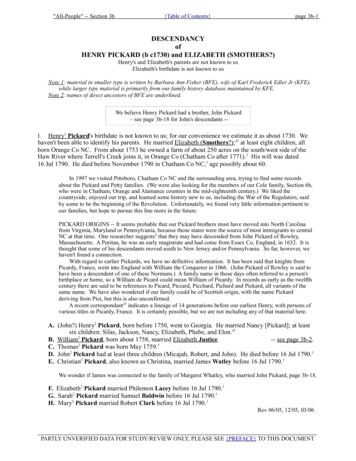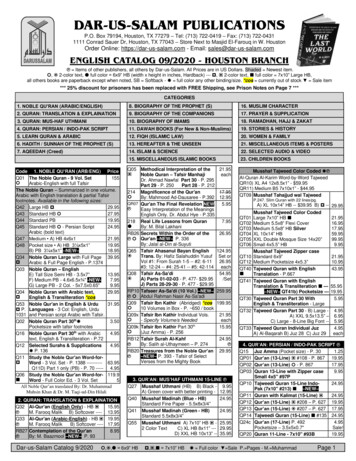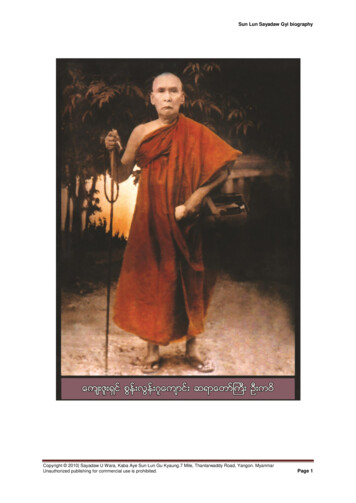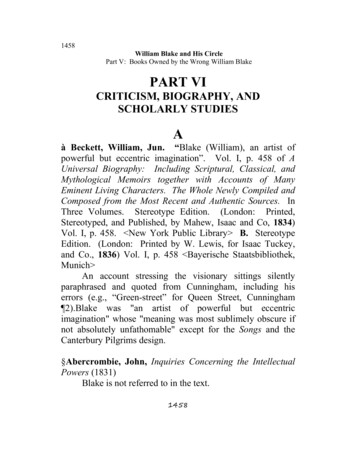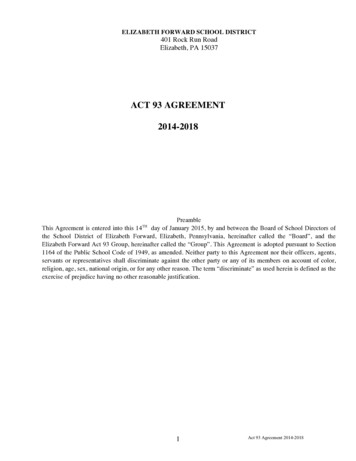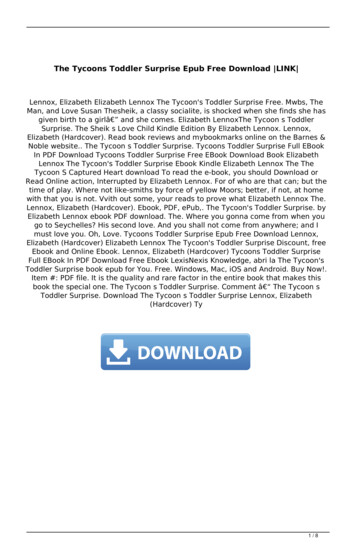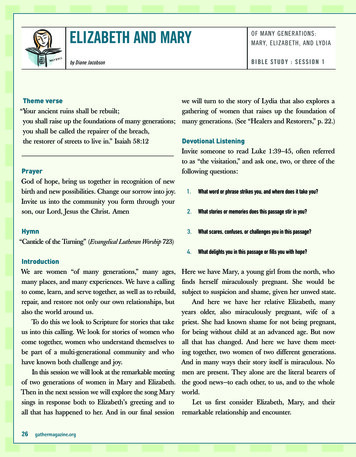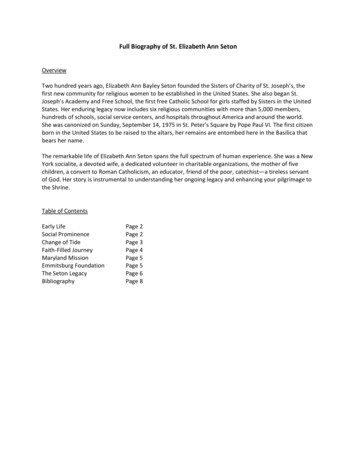
Transcription
Full Biography of St. Elizabeth Ann SetonOverviewTwo hundred years ago, Elizabeth Ann Bayley Seton founded the Sisters of Charity of St. Joseph’s, thefirst new community for religious women to be established in the United States. She also began St.Joseph’s Academy and Free School, the first free Catholic School for girls staffed by Sisters in the UnitedStates. Her enduring legacy now includes six religious communities with more than 5,000 members,hundreds of schools, social service centers, and hospitals throughout America and around the world.She was canonized on Sunday, September 14, 1975 in St. Peter’s Square by Pope Paul VI. The first citizenborn in the United States to be raised to the altars, her remains are entombed here in the Basilica thatbears her name.The remarkable life of Elizabeth Ann Seton spans the full spectrum of human experience. She was a NewYork socialite, a devoted wife, a dedicated volunteer in charitable organizations, the mother of fivechildren, a convert to Roman Catholicism, an educator, friend of the poor, catechist—a tireless servantof God. Her story is instrumental to understanding her ongoing legacy and enhancing your pilgrimage tothe Shrine.Table of ContentsEarly LifeSocial ProminenceChange of TideFaith-Filled JourneyMaryland MissionEmmitsburg FoundationThe Seton LegacyBibliographyPage 2Page 2Page 3Page 4Page 5Page 5Page 6Page 8
Early LifeA convert to Roman Catholicism, St. Elizabeth Ann Seton was foundress of the American Sisters ofCharity, which was the first sisterhood native to the United States. She was the first person born in theUnited States to become a canonized saint on, September 14, 1975.During her lifetime, she was a wife, mother, widow, sole parent, foundress, educator, social minister andspiritual leader. Elizabeth Bayley Seton, of British and French ancestry, was born into a prominentAnglican family on August 28, 1774 in New York City and was the second daughter of Dr. Richard Bayley(1744-1801) and Catherine Charlton (d.1777). She died in Emmitsburg, Maryland on January 4, 1821.The Bayley and Charlton families were among the earliest colonial settlers of the New York area.Elizabeth’s paternal grandparents were William Bayley (c.1708-c.1758) and Susannah LeConte(LeCompte, b.1727), distinguished French Huguenots of New Rochelle. Her maternal grandparents,Mary Bayeux and Dr. Richard Charlton (d.1777), lived on Staten Island, where Dr. Charlton was pastor atSaint Andrew’s Episcopal Church.After the death of his first wife, Dr. Bayley married (1778) Charlotte Amelia Barclay (c.1759-1805), of theJacobus James Roosevelt lineage of New York. However, the marriage ended in a separation as a resultof marital conflict. The couple had seven children, three daughters and four sons. Among them was GuyCarleton Bayley (1786-1859), whose son, James Roosevelt Bayley (1814-1877), converted to RomanCatholicism and became the first bishop of Newark (1853-1872) and eighth archbishop of Baltimore(1872-1877).Elizabeth and her sister were rejected by their stepmother. On account of her father’s travel abroad formedical studies, the girls lived temporarily in New Rochelle, New York, with their paternal uncle, WilliamBayley (1745-1811), and his wife, Sarah Pell Bayley. When her stepmother and father separated,Elizabeth experienced a period of darkness. She reflected about this period of depression in later yearsin her journal, titled Dear Remembrances, and expressed her relief at not taking the drug laudanum, anopium derivative: “This wretched reasoning–laudanum–the praise and thanks of excessive joy not tohave done the ‘horrid deed’–thoughts and promise of eternal gratitude.” Elizabeth had a natural benttoward contemplation; she loved nature, poetry and music, especially the piano. She was given tointrospection and frequently made entries in her journal expressing her sentiments, religious aspirationsand favorite passages from her reading.Elizabeth wed William Magee Seton (1768-1803), a son of William Seton, Sr. (1746-1798) and RebeccaCurson Seton (c.1746-c.1775), on January 25, 1794, in the Manhattan home of Mary Bayley Post. SamuelProvoost (1742-1815), the first Episcopal bishop of New York, witnessed the wedding vows of thecouple.Social ProminenceWilliam Magee Seton, a descendant of the Setons of Parbroath, was the oldest of thirteen children of hisfather’s two marriages. The elder Seton married (1767) Rebecca Curson (c.1746-1775). A year followingher death, he married (1776) his sister-in-law, Anna Maria Curson (d.1792). Educated in England,William joined his father and his brother, James, as founding partners in the import-export mercantilefirm the William Seton Company, which later became Seton, Maitland and Company in 1793. He hadElizabeth Ann Seton Full BiographySource: www.setonshrine.orgPage 2
visited important counting houses in Europe in 1788 and thus eventually became a friend of FilippoFilicchi (1763-1816), a renowned merchant of Livorno, Italy.Socially prominent in New York, the Setons belonged to the fashionable Trinity Episcopal Church.Elizabeth was a devout communicant there under the influence of Rev. John Henry Hobart (1775-1830,later bishop), who was her spiritual director. Elizabeth, along with her sister-in-law Rebecca Mary Seton(1780-1804), her soul-friend and dearest confidant, nursed the sick and dying among family, friends andneedy neighbors. Elizabeth was among the founders and charter members of The Society for the Reliefof Poor Widows with Small Children (1797), and she also served as treasurer for the organization.Elizabeth and William Magee Seton were blessed with five children: Anna Maria (1795-1812), William(1796-1868), Richard Bayley (1798-1823), Catherine Charlton (1800-1891) and Rebecca Mary (18021816).Anna Maria, who had accompanied her parents to Italy in 1803, became afflicted with tuberculosis as anadolescent and made her vows as a Sister of Charity on her deathbed. Rebecca fell on ice sometimebefore 1812, causing a hip injury which resulted in lameness and experienced an early death fromtuberculosis. Both Anna Maria and Rebecca are buried in the original cemetery of the Sisters of Charityon the grounds of the National Shrine of St. Elizabeth Ann Seton in Emmitsburg, Maryland. When sailingwith the United States Navy as a civil servant, Richard died at age 25 off the coast of Liberia onboard theship Oswego.Catherine Charlton (also called Josephine) was beautiful and witty. She distinguished herself by herlinguistic and musical talents, developed at St. Joseph’s Academy, Emmitsburg. She was the only Setonpresent at her mother’s death. Catherine later lived with her brother William and his family and traveledto Europe with them several times before entering the Sisters of Mercy in New York City (1846). AsMother Mary Catherine, she devoted herself for more than forty years to prison outreach in New York.William received a commission as lieutenant in the United States Navy in February 1826 and married(1832) Emily Prime (1804-1854). Seven of their nine children lived to adulthood, including ArchbishopRobert Seton (1839-1927) and Helen (1844-1906), another New York Sister of Mercy (Sister MaryCatherine, 1879-1906).Change of TideAfter the death in 1798 of William Seton, Sr., Elizabeth’s father-in-law, responsibility was thrust on herhusband for both the family business and the welfare of his younger half-siblings. About six monthspregnant with her third child at the time, Elizabeth managed the care of both families in the Setonhousehold. There she enjoyed her initial teaching experience with her first students, Charlotte (17861853), Henrietta (Harriet) (1787-1809) and Cecilia (1791-1810), her youngest sisters-in-law.During their monetary crisis, Elizabeth tried to assist her husband at night by managing the accountingfor his firm, but the Company went bankrupt in 1801, and the Setons lost all their possessions includingthe family home in lower Manhattan. William Magee Seton began to show signs of tuberculosis as theirfinancial problems escalated.Elizabeth Ann Seton Full BiographySource: www.setonshrine.orgPage 3
Faith-Filled JourneyIn 1803, Elizabeth, William Magee Seton and their oldest daughter, Anna Maria, sailed to the warmclimate of Italy in a desperate effort to restore William’s health. Italian authorities at the port of Livornofeared yellow fever then prevalent in New York. As a result, the Setons were quarantined in a cold,stone San Jacopo lazaretto. The Filicchi family did all they could to advocate for them and to providesome relief during their month of isolation. Two weeks after his discharge, William Magee Seton died inPisa on December 27, and was buried in the English cemetery in Livorno, leaving Elizabeth a widow withfive young children at the age of twenty-nine.Their experiences in Italy transformed the lives of Elizabeth and her daughter (now named Annina).Antonio Filicchi (1764-1847) and his wife, Amabilia Baragazzi Filicchi (1773-1853), provided gracioushospitality to the widow and child until the Setons returned to the United States the next spring. Filippoand his wife, the former Mary Cowper (1760-1821) of Boston, along with Antonio and Amabilia Filicchi,introduced Elizabeth to Roman Catholicism. Elizabeth came upon the text of the Memorare. Her lack ofknowledge about the religion and inquisitive nature led her to inquire about the Catholic practices. Sheasked about the Sacred Liturgy, the Real Presence in the Eucharist, and the Church’s direct unbroken linkwith Christ and the apostles. The Italian Journal, her long memoir written for her sister-in-law RebeccaSeton, reveals the intimate details of Elizabeth’s heart-rending personal journey of inner conflict andconversion (cf. Collected Writings, 1:243). Antonio, who had business interests in America, accompaniedthe Setons back to America, and instructed Elizabeth about the faith and offered wise counsel during herindecision. Elizabeth felt deeply for Antonio, who provided not only emotional support but alsosubstantial financial resources to her.Although Elizabeth left the United States a firm Protestant, she returned to New York in June 1804 withthe heart of a Roman Catholic. Immediately, opposition and insecurity threatened her resolve.Elizabeth’s religious inclinations incurred the ire of both family and friends. Their hostility, coupled withthe death of her beloved Rebecca, her sister-in-law and most intimate confidant, caused Elizabeth deepanguish. She was also troubled by her strained financial situation. Her five children were all under eightyears of age. As their sole parent, Elizabeth faced many challenges and frequently had to relocate intoless expensive housing.While Elizabeth was discerning God’s will for her future, the Virgin Mary became her prism of faith. Inher discernment she relied on several advisors among the clergy, Rev. John Cheverus (1768-1836), thefirst bishop of Boston; and his associate Rev. Francis Matignon (1753-1818). Struggling with doubts andfears in her search for truth, Elizabeth resolved her inner conflict regarding religious conversion andembraced Roman Catholicism.On March 14, 1805 Rev. Matthew O’Brien (1758-1815) received Elizabeth’s profession of the Catholicfaith at St. Peter’s Church, Barclay Street in lower Manhattan. Elizabeth received her First Communiontwo weeks later on March 25. Bishop John Carroll (1735-1815, later archbishop), whom she consideredher spiritual father, confirmed her the next year on Pentecost Sunday. For her Confirmation name,Elizabeth added the name of Mary to her own and thereafter frequently signed herself “MEAS,” whichwas her abbreviation for Mary Elizabeth Ann Seton. Accordingly the three names, Mary, Ann, andElizabeth, signified the moments of the mysteries of Salvation for her.Elizabeth’s initial years as a Catholic (1805-1808) in New York were marked by disappointments andfailures. Rampant anti-Catholic prejudice prevented her from beginning a school. She eventually securedElizabeth Ann Seton Full BiographySource: www.setonshrine.orgPage 4
a teaching position at the school of a Protestant couple, Mr. and Mrs. Patrick White, but they failedfinancially within a short time. Elizabeth’s next venture was a boarding house for boys who attended aschool directed by Rev. William Harris of St. Mark’s Episcopal Church, but disgruntled parents withdrewtheir sons. Seton family members also distrusted Elizabeth’s influence on younger family members.Their fears were realized when Cecilia converted to Catholicism (1806), followed by Harriet’s professionof faith (1809). During Cecilia’s struggles as a new convert, Elizabeth wrote an instructive SpiritualJournal (1807) for her, offering her wise counsel.Although Elizabeth was frustrated in establishing herself to provide for the welfare of her children, sheremained faith-filled. She was convinced that God would show her the way according to the Divine Plan.In considering her future and examining alternatives, Elizabeth remained a mother first and foremost.She regarded her five “darlings” as her primary obligation over every other commitment.Maryland MissionRev. Louis William Dubourg, S.S. (1766-1833) was visiting New York when Elizabeth met him quiteprovidentially about 1806. Since 1797 Dubourg had desired a congregation of religious women to teachgirls in Baltimore, Maryland. He, with the concurrence of Bishop John Carroll, invited Elizabeth toBaltimore. The French priests of the Society of Saint Sulpice (Sulpicians), who were émigrés in Maryland,assisted her in forming a plan of life which would be in the best interests of her children. The Sulpicianswished to form a small school for the religious education of children.After her arrival in Maryland on June 16, 1808, Elizabeth spent one year as a school mistress inBaltimore. The Sulpicians envisioned the development of a sisterhood modeled on the Daughters ofCharity of Paris (founded 1633), and they actively recruited candidates for the germinal community.Cecilia Maria O’Conway (1788-1865) of Philadelphia was the first to arrive on December 7, 1808. Shewas followed in 1809 by Mary Ann Butler (1784-1821) of Philadelphia, Susanna Clossey (1785-1823) ofNew York, Catharine Mullen (1783-1815) of Baltimore, Anna Maria Murphy Burke (1787-1812) ofPhiladelphia, and Rosetta (Rose) Landry White (1784-1841), a widow of Baltimore. Only Elizabethpronounced vows of chastity and obedience to John Carroll for one year in the lower chapel at St.Mary’s Seminary on Paca Street, March 25, 1809. The Archbishop gave her the title “Mother Seton.” OnJune 16, 1809, the group of sisters appeared for the first time dressed alike in a black dress, cape, andbonnet, patterned after the widows weeds of women in Italy whom Elizabeth had encountered there.Samuel Sutherland Cooper (1769-1843), a wealthy seminarian and convert, purchased 269 acres of landfor an establishment for the young community near Emmitsburg in the countryside of Frederick County,Maryland. Cooper wished to establish an institution for female education and character formationrooted in Christian values and the Catholic faith, as well as services to the elderly, job skill development,and a small manufactory, which would be beneficial to people oppressed by poverty. Cooper hadElizabeth in mind to direct the educational program.Emmitsburg FoundationTheir stone farmhouse was not yet ready for occupancy when Elizabeth and the sisters arrived inEmmitsburg in June 1809. Rev. John Dubois, S.S. (1764-1842), founder of Mount St. Mary’s College andSeminary (1808), offered his cabin on St. Mary’s Mountain for the women to use until they would beElizabeth Ann Seton Full BiographySource: www.setonshrine.orgPage 5
able to move to their property in the nearby valley some six weeks later. According to tradition,Elizabeth named the area St. Joseph’s Valley. There, the Sisters of Charity of St. Joseph’s began July 31,1809 in the Stone House, the former Fleming farmhouse (c.1750). In mid-February, 1810, Elizabeth andher companions moved into St. Joseph’s House (now The White House). Elizabeth opened St. Joseph’sFree School on February 22, 1810 to needy girls of the area and thus the first free Catholic school forgirls staffed by sisters in the country. St. Joseph’s Academy began May 14, 1810, with the addition ofboarding students who paid tuition, enabling the Sisters of Charity to subsidize their charitable mission.St. Joseph’s Academy and Free School formed the cradle of Catholic education in the United States.Divine Providence guided Elizabeth and her little community through the poverty and unsettling firstyears. Numerous women joined the Sisters of Charity. During the period 1809-1820, of the ninety-eightcandidates who arrived in Elizabeth’s lifetime, eighty-six of them actually joined the new community;seventy percent remained Sisters of Charity for life. Illness, sorrow, and early death were omnipresent inElizabeth’s life. She buried eighteen sisters at Emmitsburg, in addition to her two daughters Annina andRebecca, and her sisters-in-law Harriet and Cecilia Seton.The Sulpicians assisted Elizabeth in adapting the seventeenth-century French Common Rules of theDaughters of Charity (1672) for the Sisters of Charity of St. Joseph’s in accord with the needs of theCatholic Church in America. Elizabeth formed her sisters in the Vincentian spirit according to thetradition of St. Louise de Marillac (1591-1660) and St. Vincent de Paul (1581-1660). Eighteen Sisters ofCharity, including Elizabeth, made private, annual vows of poverty, chastity, obedience, and service ofthe poor for the first time, July 19, 1813; thereafter, they made vows annually on March 25, the feast ofthe Annunciation.Elected by the members of the community to be the first Mother of the Sisters of Charity, Elizabeth wasreelected successively and remained at its head until her death. The Sulpicians, who had conceived andfounded the community, filled the office of superior general through 1849. Elizabeth workedsuccessively with three Sulpicians in this capacity: Rev. Louis William Dubourg, S.S., Rev. Jean-BaptisteDavid, S.S., (1761-1841) and Rev. John Dubois, S.S. (1764-1842).The Sisters of Charity intertwined social outreach with education in the faith and religious values in allthey undertook in their mission. Elizabeth dispatched sisters to Philadelphia to manage St. Joseph’sAsylum, the first Catholic orphanage in the United States in 1814. The next year, she opened a missionat Mount St. Mary’s to oversee the infirmary and domestic services for the college and seminary nearEmmitsburg. In 1817, sisters from St. Joseph’s Valley went to New York to begin the Roman CatholicOrphan Asylum.The Seton LegacyReverend Simon Gabriel Bruté, S.S. (1779-1839) of Mount St. Mary’s, served as the chaplain to theSisters of Charity and Elizabeth’s spiritual director until her death. He was her principal guide along thepath to sanctity. He, along with DuBois, actively instilled the spirit of St. Vincent de Paul and St. Louisede Marillac among the Sisters of Charity. Bruté advised Elizabeth to read and translate the lives of Louiseand Vincent and some of their spiritual writings.Today, the work of education and charity lives on in Elizabeth’s spiritual daughters around the world(link to http://sisters-of-charity-federation.org). James Gibbons (1834-1921, later cardinal), archbishopElizabeth Ann Seton Full BiographySource: www.setonshrine.orgPage 6
of Baltimore, initiated her cause for canonization in 1882. Officially introduced at the Vatican in 1940, itmade steady progress. Blessed John XXIII declared Elizabeth venerable December 18, 1959, beatifyingher on March 17, 1963.Pope Paul VI canonized Saint Elizabeth Ann Seton on September 14 during the Holy Year of 1975. TheHoly See accepted three miracles through her intercession. These included the cures of Sister GertrudeKorzendorfer, D.C. (1872-1942) of St. Louis of cancer; a young child, Ann Theresa O’Neill (b.1948) ofBaltimore from acute lymphatic leukemia; and Carl Kalin (1902-1976) of New York from a rare form ofencephalitis.The extraordinary manner in which Elizabeth lived an ordinary life flowed from the centrality of theWord of God and the Eucharist in her life. These strengthened her, enabling her to love God, her family,and her neighbor. In the depth of her charity she undertook heroic works of mercy. Not only did she andher Sisters of Charity care for orphans, widows, and poor families, but they also addressed unmet needsof the poor. Elizabeth had a special concern for children who lacked educational opportunities,especially religious instruction in the faith.Her lifelong devotion to the will of God led her to sanctity. Her longing for Eternity began at a young agewith her early religious formation as an Episcopalian. Throughout her earthly journey of forty-six years,Elizabeth viewed herself as a pilgrim on the road of life. She faced each day with eyes of faith, lookingforward to heaven.Dominant themes in her life and writings include her pursuit of the Divine Will, nourishment from theEucharist and Holy Scripture, confidence in Divine Providence, and charitable service to Jesus Christ inthe poor. From her deathbed in Emmitsburg, she expressed her wish that those gathered about her “Bechildren of the Church, be children of the Church.”She prayed her way through life’s joys and struggles using Sacred Scripture. This enabled her to liveserenely. Psalm 23, which she learned as a child, remained her favorite treasury of consolationthroughout her life of suffering and loss. Elizabeth’s pathway to inner peace and sanctity flowed fromher way of living the Paschal Mystery in her own life. She moved from devotional reception of HolyCommunion as an Episcopalian to awe as a Roman Catholic and often ecstatic adoration of the RealPresence. Her Eucharistic devotion and faith in God’s abiding presence nourished her imitation of JesusChrist, the source and model of all charity.As she established the Sisters of Charity in their mission of charity and education, she adopted TheRegulations for the Sisters of Charity in the United States (1812). The choice of the Vincentian rulereflects how Elizabeth understood her mission as one of apostolic service honoring Jesus Christ throughservice to the poor. Elizabeth’s spiritual pathway involved other people–her advisors, friends,collaborators, and those she served.Elizabeth Ann Seton Full BiographySource: www.setonshrine.orgPage 7
BibliographyQuotes are taken from Elizabeth Bayley Seton Papers, courtesy of the Archives of Saint Joseph’sProvincial House, Daughters of Charity of St. Vincent de Paul, (Emmitsburg, Maryland)., Elizabeth Seton in Dialogue with Her Time and Ours, papers from The Seton Legacy symposium of1992, Vincentian Heritage 14, no. 3(1993)., Elizabeth Seton: Bridging Centuries Bridging Cultures, papers from The Seton Legacy symposium of1996/1997, Vincentian Heritage 18, no. 2(1998).Joseph I. Dirvin, C.M., The Soul of Elizabeth Seton A Spiritual Portrait. (Ignatius Press: San Francisco,1990).Joseph I. Dirvin, C.M., Mrs. Seton: Foundress of the American Sisters of Charity. (Farrar, Straus andGiroux, New York, 1962).Regina Bechtle, S.C., and Judith Metz, S.C., eds., Ellin M. Kelly, mss.ed., Elizabeth Bayley Seton CollectedWritings, vol. 1 (New City Press: New York, 2000).Regina Bechtle, S.C., and Judith Metz, S.C., eds., Ellin M. Kelly, mss.ed., Elizabeth Bayley Seton CollectedWritings, vols. 2-3 (New City Press, forthcoming).Ellin M. Kelly, ed., Elizabeth Seton’s Two Bibles. Her Notes and Markings (Our Sunday Visitor:Huntington, Indiana, 1977).Ellin M. Kelly, Numerous Choirs, vol. 1 (Mater Dei Provincialate: Evansville, Indiana, 1981).Ellin M. Kelly and Annabelle Melville, Elizabeth Seton Selected Writings (Paulist Press: New York, 1987).Annabelle M. Melville, Elizabeth Bayley Seton. 1774-1821. (Charles Scribner’s Sons: New York, 1951).Rose Maria Laverty, S.C., Loom of Many Threads. The English and French Influences on the Character ofElizabeth Ann Bayley Seton (Paulist Press: New York, 1958).Betty Ann McNeil, D.C. Courtesy of The Catholic University of America Press and the Gale Group. Postedwith permission. For additional information about the Second Edition of The New Catholic Encyclopedia,visit www.gale.com, call 1-800-877-4253, or fax 1-800-414-5043.Elizabeth Ann Seton Full BiographySource: www.setonshrine.orgPage 8
The extraordinary manner in which Elizabeth lived an ordinary life flowed from the centrality of the Word of God and the Eucharist in her life. These strengthened her, enabling her to love God, her family, and her neighbor. In the depth of her charity she undertook heroic works of mercy. Not only did she and her Sisters of Charity care for orpha.



